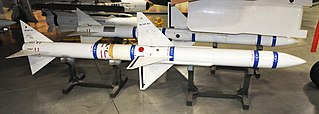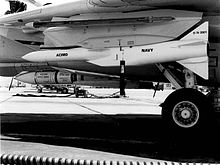
The AIM-7 Sparrow is an American medium-range semi-active radar homing air-to-air missile operated by the United States Air Force, United States Navy, United States Marine Corps, and various other air forces and navies. Sparrow and its derivatives were the West's principal beyond visual range (BVR) air-to-air missile from the late 1950s until the 1990s. It remains in service, although it is being phased out in aviation applications in favor of the more advanced AIM-120 AMRAAM.
The AIM-120 Advanced Medium-Range Air-to-Air Missile(AMRAAM) ( AM-ram) is an American beyond-visual-range air-to-air missile capable of all-weather day-and-night operations. It uses active transmit-receive radar guidance instead of semi-active receive-only radar guidance. When an AMRAAM missile is launched, NATO pilots use the brevity code "Fox Three".

The AIM-54 Phoenix is an American radar-guided, long-range air-to-air missile (AAM), carried in clusters of up to six missiles on the Grumman F-14 Tomcat, its only operational launch platform.

The Meteor is a European active radar guided beyond-visual-range air-to-air missile (BVRAAM) developed and manufactured by MBDA. It offers a multi-shot capability, and has the ability to engage highly maneuverable targets such as jet aircraft, and small targets such as UAVs and cruise missiles in a heavy electronic countermeasures (ECM) environment with a range far in excess of 200 kilometres (110 nmi).

An air-to-air missile (AAM) is a missile fired from an aircraft for the purpose of destroying another aircraft. AAMs are typically powered by one or more rocket motors, usually solid fueled but sometimes liquid fueled. Ramjet engines, as used on the Meteor, are emerging as propulsion that will enable future medium- to long-range missiles to maintain higher average speed across their engagement envelope.

The Vympel NPO R-77 missile is a Russian active radar homing beyond-visual-range air-to-air missile. It is also known by its export designation RVV-AE. It is the Russian counterpart to the American AIM-120 AMRAAM missile.

The RIM-116 Rolling Airframe Missile (RAM) is a small, lightweight, infrared homing surface-to-air missile in use by the German, Japanese, Greek, Turkish, South Korean, Saudi Arabian, Egyptian, Mexican, UAE, and United States navies. It was originally intended and used primarily as a point-defense weapon against anti-ship missiles. As its name indicates, RAM rolls as it flies. The missile must roll during flight because the RF tracking system uses a two-antenna interferometer that can measure phase interference of the electromagnetic wave in one plane only. The rolling interferometer permits the antennas to look at all planes of incoming energy. In addition, because the missile rolls, only one pair of steering canards is required. As of 2005, it is the only U.S. Navy missile to operate in this manner.

The Skyflash, or Sky Flash in marketing material, was a medium-range semi-active radar homing air-to-air missile derived from the US AIM-7 Sparrow missile and carried by Royal Air Force McDonnell Douglas F-4 Phantoms and Tornado F3s, Italian Aeronautica Militare and Royal Saudi Air Force Tornados and Swedish Flygvapnet Saab Viggens.

The RIM-162 Evolved SeaSparrow Missile (ESSM) is a development of the RIM-7 Sea Sparrow missile used to protect ships from attacking missiles and aircraft. ESSM is designed to counter supersonic maneuvering anti-ship missiles. ESSM also has the ability to be "quad-packed" in the Mark 41 Vertical Launch System, allowing up to four ESSMs to be carried in a single cell.

The Hughes AIM-4 Falcon was the first operational guided air-to-air missile of the United States Air Force. Development began in 1946; the weapon was first tested in 1949. The missile entered service with the USAF in 1956.

The AIM-26 Falcon was a larger, more powerful version of the AIM-4 Falcon air-to-air missile built by Hughes. It is the only guided American air-to-air missile with a nuclear warhead to be produced; the unguided AIR-2 Genie rocket was also nuclear-armed.
A beyond-visual-range missile is an air-to-air missile that is capable of engaging at ranges of 20 nmi (37 km) or beyond. This range has been achieved using dual pulse rocket motors or booster rocket motor and ramjet sustainer motor.

Active radar homing (ARH) is a missile guidance method in which a missile contains a radar transceiver and the electronics necessary for it to find and track its target autonomously. The NATO brevity code for an air-to-air active radar homing missile launch is fox three.

Astra is an Indian family of all weather beyond-visual-range air-to-air missile, developed by the Defence Research and Development Organisation. Different missiles of this family are capable of engaging targets at varying distances of 500 m (0.31 mi) up to 340 km (210 mi). Astra Mk-1 has been integrated with Indian Air Force's Sukhoi Su-30MKI and will be integrated with Dassault Mirage 2000, HAL Tejas and Mikoyan MiG-29 in the future. Limited series production of Astra Mk-1 missiles began in 2017.
The Mitsubishi AAM-4 is a medium-range active radar homing air-to-air missile. It is a modern beyond-visual-range missile developed in Japan and intended to replace the semi-active radar homing AIM-7 Sparrow missile in service. It has been operational since 1999. The main contractor is Mitsubishi Electric. The 2010 AAM-4B was the world's first air-to-air missile with an AESA radar seeker.
The FMRAAM was a modified ramjet powered version of the Hughes AIM-120 AMRAAM beyond visual range air-to-air missile that was conceived during the mid-1990s to fulfill British requirements for a new longer range missile to use in place of the AMRAAM on their new Eurofighter Typhoon fighter. It competed with and lost to the MBDA Meteor, thus never reaching production.

The Mikoyan-Gurevich Ye-150 family was a series of prototype interceptor aircraft designed and built by the Mikoyan-Gurevich design bureau in the Soviet Union from 1955.
Blue Envoy was a British project to develop a ramjet-powered surface-to-air missile. It was tasked with countering supersonic bomber aircraft launching stand-off missiles, and thus had to have very long range and high-speed capabilities. The final design was expected to fly at Mach 3 with a maximum range of over 200 miles (320 km).

The AAM-N-10 Eagle was a long-range air-to-air missile developed by the Bendix Corporation for use by the United States Navy. Intended for carriage by the Douglas F6D Missileer fleet defense fighter, the Eagle program was cancelled before testing could begin, but the lessons learned were used in the development of the AIM-54 Phoenix missile.

The PL-15 is an active radar-guided long-range air-to-air missile developed by the People's Republic of China.
















